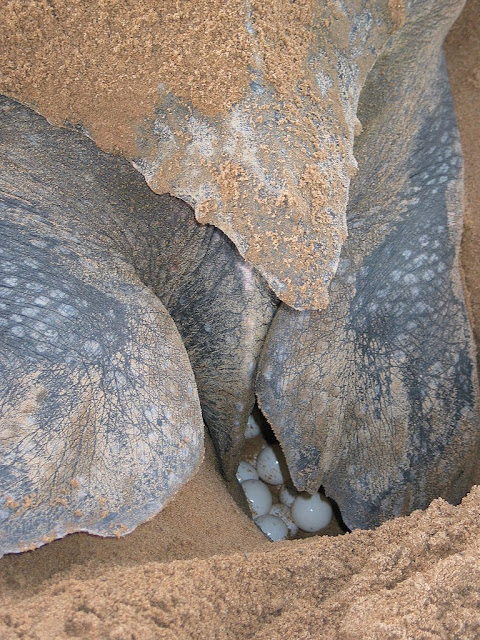Gerry is a Malaysian based marine
ecologist, Research Fellow and Advisor to the National University of Malaysia,
and marine consultant to the Andaman Resort, Langkawi.
I saw my first Leatherback turtle in the Florida Keys long before that string of gorgeous islands
became the foundation of endless high-rise buildings. It reminded me of a
flattened car; it was huge!
Leatherback turtles can grow to over 3 m long and weigh nearly
1,000 kg. Its front flippers can reach an amazing 2.7 m. They dive to depths of
more than 1,000 m and can make trans-Pacific migrations from Indonesia to
the U.S. Pacific coast and back again. Surprisingly, they are no larger than
other sea turtles at hatching weighing in at only 46 g.
More amazing is that these ancient giants that evolved about 110
million years ago feed almost exclusively on jellyfish. They follow their prey
into deep water by day and shallow water by night. They range from the tropics
to water as cold as 0.4 °C.
How can such an impressive animal get into trouble?
Recent
estimates of global nesting populations are that 26,000 to 43,000 females nest
annually, which is a dramatic decline from the 115,000 estimated in 1980. Now an international team led by the University of Alabama at Birmingham (UAB) has discovered
a frightening 78 percent fall in the number of nests. The leatherback sea
turtle (Dermochelys coriacea) is already critically endangered (IUCN)
and the turtle's last stronghold in the Pacific Ocean
is now collapsing according to this February 26 report in Ecosphere.
Leatherback nests at Jamursba
Medi Beach
in Papua Barat, Indonesia now account for 75
percent of the total Leatherback nesting in the western Pacific. Tragically,
nesting has fallen from a peak of 14,455 in 1984 to a low of 1,532 in 2011.
Less than 500 leatherbacks now nest at this site annually. A nearby ‘secondary’
nesting site at Wermon
Beach, Papua Barat now
supports less than 1,000 nests and is failing as well.
The team identified four major problems facing leatherback
turtles: beach predators, such as pigs and dogs that were introduced to the
island now eat the turtle eggs; rising sand temperatures kill the eggs or
prevent the production of male hatchlings; the danger of being caught by
fisheries during migrations; and harvesting of adults and eggs for food by
islanders. It is this last factor that has the greatest impact on these gentle
giants.
People around the world annually harvest sea turtle eggs. Asian
exploitation of turtle nests has been cited as the most significant factor for
the species' global population decline. In Southeast Asia, egg harvesting in
countries such as Thailand
and Malaysia
has led to a total collapse of local nesting populations. In Malaysia, where
the turtle is virtually locally extinct, the eggs are considered a delicacy. In
the Caribbean, some cultures believe the eggs
are aphrodisiacs.
"The leatherback is one of the most intriguing animals in
nature, and we are watching it head towards extinction in front of our
eyes," said Dr. Wibbels of the University
of Alabama at Birmingham.
The Leatherback’s vulnerability lies in its extraordinary migrations.
Travelling more than 7,000 km from Indonesia
to California
takes it through the territories of at least 20 countries. Many have different
laws and varying enforcement.
Mr. Tapilatu,
a native of western Papua, Indonesia, and research team member
has studied Leatherback turtles and worked on their conservation since 2004.
His work has been recognized by NOAA, and he will head the Leatherback
conservation program in Indonesia.
Conservation will
rely heavily on education of local people and be backed up by a Leatherback
hatchery. The hatchery will relocate nested eggs to more suitable temperatures
and predator-free locations. But more must be done to protect the giant
Leatherbacks on their trans-oceanic migrations.
"Only one hatchling out of 1,000 makes it to adulthood, so
taking out an adult makes a significant difference on the population," Dr.
Wibbels said. "It is essentially the same as killing 1,000
hatchlings."
"If the decline continues, within 20 years it will be
difficult if not impossible for the Leatherback to avoid extinction," said
Dr. Wibbels. "That means the number of turtles would be so low that the
species could not make a comeback.
Is it only coincidence that the approaching extinction of a
jellyfish predator is reported among headlines from around the world describing
the almost global jellyfish ‘plagues’ that now close beaches, foul nets, and
block seawater intakes on a daily basis?
http://youngmarinescientist.blogspot.com/
http://geraldgoeden.blogspot.com/
http://goedensnews.blogspot.com/
http://goedensnews.blogspot.com/
http://goedenquotes.blogspot.com/
http://goedenscience.blogspot.com/
http://goedenmarineecology.blogspot.com/
http://gerryquotes.blogspot.com/
http://einsteinsnature.blogspot.com/
http://drgerrygoeden.blogspot.com/
http://underwaterinternet.blogspot.com/
http://goedenshark.blogspot.com/






No comments:
Post a Comment